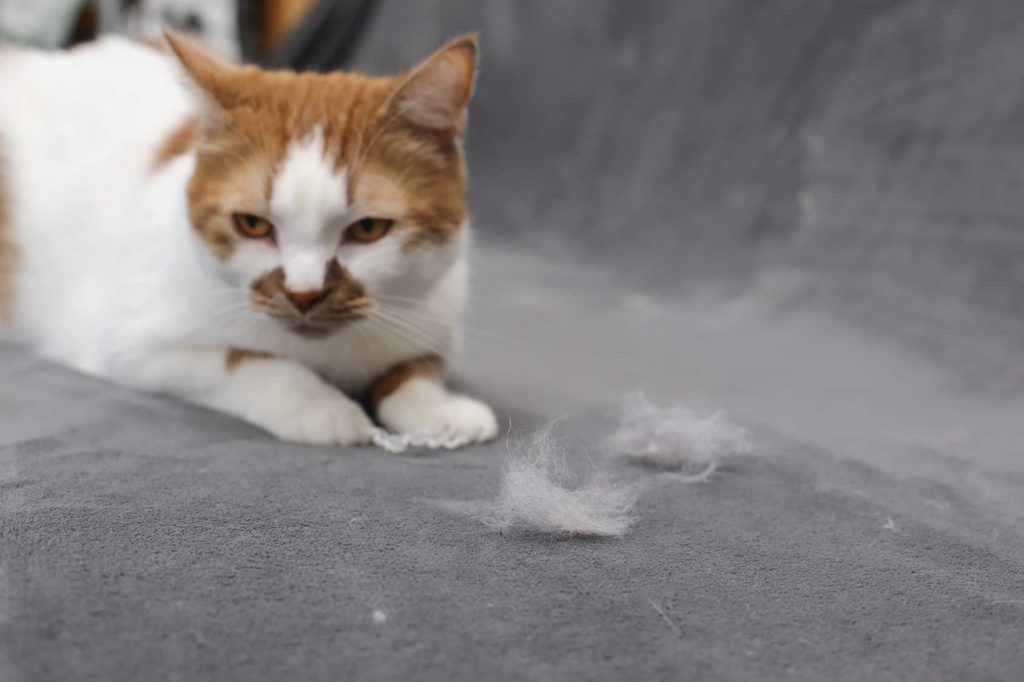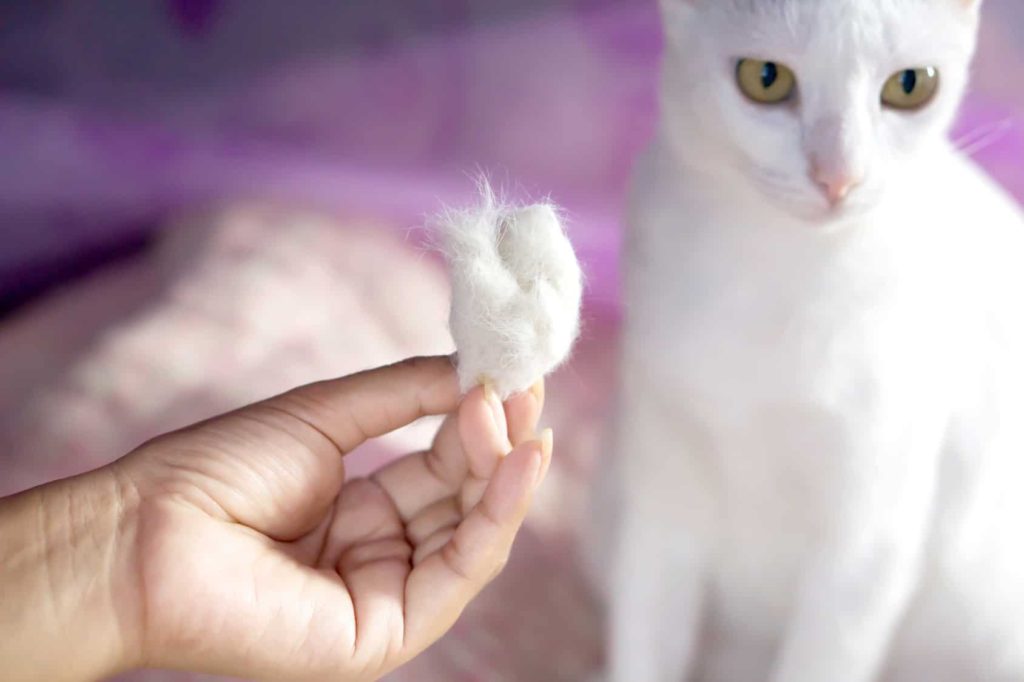Many people don’t like cats because of the amount of hair they shed, but not all cats shed excessively. If you’re considering bringing home a new feline friend, first research do cats shed a lot to determine if a particular breed would be a good addition to your home. As an example, Persians tend to shed much more compared to a short-haired tabby. But there are also some instances in which excessive shedding is not normal and can be a major indicator that something is going on with your pet.
Do cats shed a lot? Some breeds will shed more than others. Long-haired cats will appear to shed more than short-haired cats because of their long, luxurious fur. Additionally, cats tend to shed more during the fall and summer months to prepare for the upcoming changes in temperature.
If you feel that your cat is shedding more than usual and it’s accompanied by other symptoms, such as bald patches, a lack of energy or appetite, excessive grooming, or weight loss, make an appointment with your vet to rule out an underlying health condition.
Keep on reading to learn more about what’s normal in terms of shedding and what signs and symptoms to look for that can indicate your pet may be dealing with an underlying health condition.
The Natural Shedding Process
All cats will shed, it’s an inescapable fact unless you’ve decided to go with a hairless breed. But why do cats shed, and why do some seem to shed more than others?
A cat will shed to get rid of unnecessary, dead hair. While your cat’s coat is very soft and fluffy, it also serves a purpose. When cats were wild, they lived outside where a regenerative, tough coat was a must to regulate their body temperature. With the exception of hairless cats, all felines shed. But you should be concerned if your cats begin to shed excessively.

If you’ve noticed that your cat has begun to shed more than normal, over a period of several months, then it’s time to call your vet for an assessment. Below, you’ll find the most common culprits that could cause your feline to shed more than usual:
- Allergies: Most cats will shed more in the fall and spring as they prepare for major changes in temperature. If you notice excessive shedding other than these times of
year , then your cat may have allergies. A cat can have seasonal allergies just like a human and may be allergic to pollen, ragweed, or may have even developed a new food allergy. An allergy can cause bald patches, itchiness, and rashes. Shedding will usually result if their skin is unbalanced due to a seasonal allergy or an environmental one.
- Ringworm: This fungal infection can affect a cat at any age. In kittens, the signs may be more obvious, while in adults, the symptoms are usually very subtle. In younger cats, the infection can be identified easily by looking at their paws, face, and ears. Adult cats who get infection will develop skin problems that can result in broken and brittle hair. You should have your cat checked out immediately if you suspect ringworm since it’s highly contagious for both people and animals.
- Thyroid problems: Thyroid problems are considered the most common reasons cat owners take their pet to the vet. A thyroid that produces too much or not enough hormones can cause problems in pets of any age. However, it’s more commonly found in cats that are over the age of ten. Symptoms of thyroid problems in cats can vary, which can make it difficult to spot. Hair loss, weight loss, and an increase or decrease in their activity level are all major signs of a thyroid problem. Fortunately, this condition can easily be managed with medication.
- Behavioral: Some felines may deal with their anxiety and stress by developing a condition called psychogenic dermatitis, which causes them to excessively groom themselves. On the other hand, if your cat is feeling too stressed or sick, they may stop grooming altogether, which can lead to excessive shedding.
- Atopic dermatitis: This is a type of inflammatory skin condition that cats can get in response to an environment allergy or a reaction to fleas. Flea dermatitis can affect one out of five cats and can cause your cat to groom excessively. With this condition, the cat is allergic to the flea’s saliva. Once the cat is bitten, the saliva will cause a skin reaction, including swelling, irritation, and itchiness. This causes the cat to groom constantly in order to minimize the irritation. Unfortunately, this usually results in a huge hot spot and hair loss. Flea medications that will kill the fleas before they bite are essential. Many cat owners have had the best success with newer flea collars, such as the Seresto collar, which kills the fleas the moment they land on your pet.
When to Get Help
If your cat is shedding more than normal, observe them for other symptoms, including changes in behavior, diarrhea, and lethargy. These symptoms can help your vet determine the underlying cause of the shedding.
If your vet has determined that your cat’s shedding is normal, then you’ll need to do your best to control the effects of their shedding in the home. Speak with your vet about adding a new brand of pet food or a fatty acid supplement.
Brushing your pet daily can also cut down on the amount of cat hair that’s left behind on clothing and furniture. You can use a type of de-shedding tool to remove any trapped fur, dirt, and debris. The tool will also remove fallen or loose fur.
You can also use a topical product that’s designed to promote a healthy coat. Make sure you speak with your vet prior to using the product, especially if your cat’s excessive shedding is due to an allergy.
Another way to cut down on shedding is to eliminate any stressors in the home. Keep an eye on your cat’s behavior to determine what’s causing them stress. This can be as simple as moving the litter box, changing the type of litter you use or bringing a new animal into the home. Some pet owners have reported that bringing home a new baby can also cause significant stress and anxiety in pets. Of course, the only solution here is to pay more attention to your cat. You can also purchase toys, treats, and other products that will help to keep your cat calm, distracted, and happy.
Which Cats Shed the Most?
As I mentioned earlier, Persians are notorious shedders, and they require daily brushing to prevent mats. The fact that some cats shed more than others has to do with hair length. Cats like American Bobtails or Ragamuffins tend to lose more fur because their coat is longer. However, there are some exceptions. The Russian Blue has a short coat but is also prone to excessive shedding. Ocicats and Bengals have longer coats but don’t shed much, which is why some pet owners believe that they’re more hypoallergenic than other breeds.
If shedding is a concern, then a hairless breed, such as a sphinx, may be a better option. However, because they don’t have a coat to protect their skin they tend to be more high maintenance than other breeds, not to mention the initial cost of the pet can run into the hundreds or thousands of dollars in some cases.

Related Questions
How Do I Get Cat Hair Off My Furniture?
There are many methods you can try, ranging from tape, and dishwashing gloves, but I’ve found that using the best vacuum for pet hair is the easiest, fastest, and most efficient method. Many of these vacuums, such as the Shark Rocket (HV302), come with a variety of attachments that you can use to suck up pet hair from hard to reach places including stairs, behind your dresser, and under the bed.
Do Dogs Shed for the Same Reasons as Cats?
Yes. Some breeds shed more than others, such as working breeds, which have two coats. However, dogs also shed seasonally, or they may start to shed excessively if there is an underlying health issue that needs to be addressed. To learn more about the common reasons dogs shed, click here to read my dog shedding guide.
Is it Safe to Shave a Cat?
Most groomers will tell you no. Shaving a cat, even a long-haired one, should only be done if it’s medically necessary. Many pet owners mistakenly believe that their long-haired cat is suffering during the hotter months of the year, but their fur is designed to keep them cool and dry. If you shave your cat, their body will not be used to regulating the temperature, and it can make it very difficult for your cat to stay cool and comfortable in the heat. You should only shave a cat if their coat is severely matted or they’re dealing with a skin condition such as flea dermatitis or they have hot spots. Before you shave your pet, make sure you consult your groomer or vet.
Final Thoughts
Do cats shed a lot? Yes, however, some breeds will shed more than others. If your cat is constantly shedding excessively, then it’s important that you make an appointment with your vet so they can determine whether your cat is shedding more than normal. With long-haired breeds, you can expect a higher shed volume, or what appears to be more shedding than usual, simply because they have longer hair. If you notice that your cat’s shedding is accompanied by bald patches, a lack of appetite decreased energy, or hot spots, make an appointment with your vet right away.
